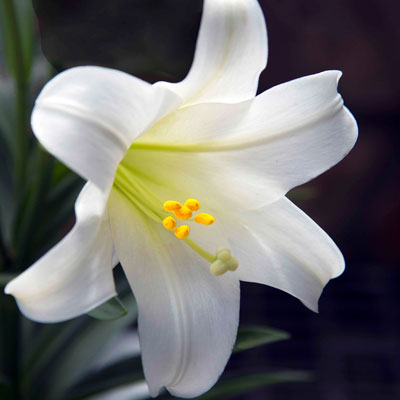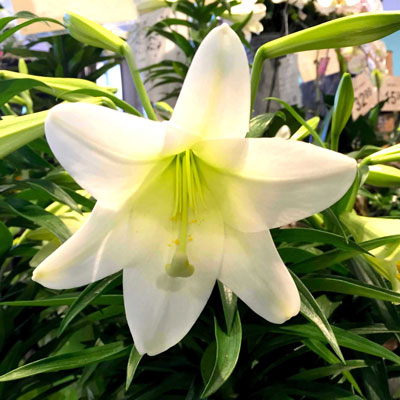The Low-down on Easter Lilies

Perhaps you have a beautiful Easter lily gracing your table right now, ready for one of Christians’ most sacred holidays as families gather.
Let me lend you some ways to get the most possible enjoyment out of your lily for the longest time. Then I’ll tell you what a troublemaker it is for the growers.

Extending your lily’s bloom time…
Here are the critical tips.
• If your plant came in a paper sleeve, remove the sleeve from the bottom up. Tear it away carefully. Don’t try to save the sleeve. What on earth will you do with an old sleeve anyway?
• Place the plant in a cool, bright spot that is out of hot drafts.
• Keep it moist at all times. Don’t let it wilt, but don’t leave it standing in water.

• As new flowers open, carefully pinch off the anthers (containing pollen) before they open and expose the sticky pollen. Tweezers work wonderfully.
• When a flower has folded up, trim it off. When all the flowers have finished, plant the lily out into your perennial garden this spring while its leaves are still green. They will provide food for the bulb for next year’s growth. Don’t trim them off until they turn yellow later in the summer. Just to note: lilies do best with morning sun and afternoon shade.
• Mark its location in your garden so you won’t forget about it. It will sprout and bloom next year and for perhaps one or two years beyond.
A worthy note: If you happen to get pollen on a shirt or blouse, don’t try to daub it off. It’s too oily and sticky and you’ll only smear it around. Put the fabric out in direct sunlight for a few hours. The pollen will dry and disappear. If you still can detect it, you may have to put it out for a second day in the sun, but it really will work. I was amazed. This was taught to me by a now retired florist friend.
Why greenhouse growers don’t like Easter lilies…
Greenhouse growers prefer crops that are predictable. Plant them on a specific date and they’ll be ready on another specific date.
There is too much variability in growing Easter lilies:
• Easter falls on a different day every year. It can fall as early as March 22, or it can be as late as April 25. Those dates are the extremes, and they’re rare, but they point out how much the holiday moves around. To a grower that tells them that what they learn this year may or may not be of much value next year.
• Easter lilies are priced according to the number of buds and flowers on each plant. You want the first buds just to be opening during Holy Week. The grower must “warm ‘em up” to speed the plants along or “cool ‘em down” if they’re coming along too rapidly. If they make the changes too abruptly, the plants start to abort (“blast”) buds.
• Winter and early spring conditions can vary from one year to the next. Some years we have “warm winters.” Other years we have “cold springs.”
(We’ve been near 90F in DFW already a couple of weeks ago, and it was snowing in Amarillo on Monday this week.)

• Lilies are grown from bulbs, and quality of those bulbs can vary – much more than cuttings or seeds of other greenhouse crops.

• Those bulbs are produced primarily in the Northwestern U.S., and conditions there are cool and moist. But their weather varies from one year to the next, too. That impacts when the bulbs arrive. It also impacts the bulbs’ quality and vigor.
So, have respect for those great people who produce beautiful lilies for us at Easter. They are martyrs to the cause. Growing petunia hanging baskets would have been so much easier.
Happy Easter, everyone.
